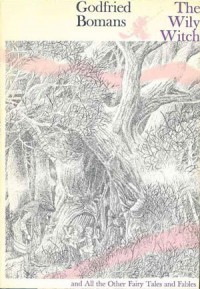108
Followers
112
Following
Aerin
"Books are the plane, and the train, and the road. They are the destination, and the journey. They are home."
- Anna Quindlen
Review: The Wily Witch, by Godfried Bomans

It's a risky proposition to go back and reread books that meant a lot to you as a child. They often warp or shrink or mildew to mulch over time.
I first read The Wily Witch somewhat late in my sheltered childhood. I was in the sixth or seventh grade, and it had never occurred to me that fairy tales could be dark or subversive or lewd. Not that this book pushes any of those boundaries very far, but there are some twisted endings, some questionable morals, and a boob or a penis or two in the illustrations.
... I guess I should back up for a minute and describe what this book even is. Godfried Bomans was a beloved Dutch author, humorist, and TV personality who was active from the 50's to his death in 1971. Among other things, he was known for writing witty modern fairy tales (sprookjes). Though his work remains somewhat popular in the Netherlands, most of his books were never translated into English, and I don't think The Wily Witch ever made much of a splash in the English-speaking world.
I originally found it in my school library in Ohio - god knows why they had a copy. The book contains a few dozen fairy tales, none more than a couple of pages long, along with the original (and charmingly bizarre) illustrations by Wouter Hoogendijk.
There are two stories I distinctly remembered from reading it back then:
1) "The Innkeeper of Pidalgo", whose titular character is known throughout the land for his succulent roast. When a famine strikes, he is heartbroken - not because his family is starving (though they are), but because he can no longer enchant travelers with his cooking. When the king stops by and requests the famous roast, the innkeeper can't bring himself to refuse. In a few days' time, he manages to obtain and prepare the most amazing cut of meat for the king and his entourage. Everyone marvels over it until one of the courtiers notices that the sickly-looking Innkeeper has a wooden leg...
2) "The King in His Undershirt", which is about a king who, while frolicking through a cornfield for no apparent reason, realizes he has to take a shit. That's basically the entire story, but it's really the illustration that stuck in my memory:

So I mean, it's really pretty mild stuff. But at the time I thought this book was ridiculously cool.
Rereading it now, I realized that the reason I didn't remember most of the other stories is that they are fairly unmemorable, though some are quite funny and some are refreshingly bleak. It's really the illustrations that feel subversive to me now - it's one thing to read a story about a bunch of angry villagers murdering a poor blackberry picker (he convinced them he was rich, when really it was just nature that was his palace), it's another to see a full-page illustration of him hanging from a tree. And, in another story about a man who was despised for being too happy all the time, I could really do without the depiction of his gory decapitated head laughing manically on the scaffold.
So I can really only recommend this book as a curio. It's too graphic for young children, but it's not twisted or salacious enough to interest fans of more adult-oriented fairytale reimaginings. While many of the stories are sly and satirical, there are just as many that are cloyingly earnest. It's just as sexist as any medieval specimen of the genre, and it doesn't push the envelope compellingly far in any particular direction.
But it DOES have that bare-assed pooping king. So... at least there's that.



